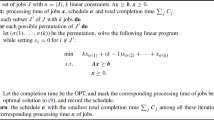Abstract
For the \(\mathcal{NP}\)-hard problem of scheduling n jobs in a two-machine flow shop so as to minimize the total completion time, we present two equivalent lower bounds that are computable in polynomial time. We formulate the problem by the use of positional completion time variables, which results in two integer linear programming formulations with O(n 2) variables and O(n) constraints. Solving the linear programming relaxation renders a very strong lower bound with an average relative gap of only 0.8% for instances with more than 30 jobs. We further show that relaxing the formulation in terms of positional completion times by applying Lagrangean relaxation yields the same bound, no matter which set of constraints we relax.
Similar content being viewed by others
References
Akkan, C. and S. Karabati, “The two-machine flowshop total completion time problem: Improved lower bounds and a branch-and-bound algorithm,” European Journal of Operational Research, 159, 420–429 (2004).
Cadambi, B. W. and Y. S. Sathe, “Two-machine flowshop scheduling to minimise mean flow time,” Opsearch, 30, 35–41 (1993).
Conway, R. W., W. L. Maxwell, and L. W. Miller, Theory of Scheduling. Addison-Wesley, Reading, MA, (1967).
Della Croce, F., M. Ghirardi, and R. Tadei, “An improved branch-and-bound algorithm for the two machine total completion time flow shop problem,” European Journal of Operational Research, 139, 293–301 (2002).
Della Croce, F., V. Narayan, and R. Tadei, “The two-machine total completion time flow shop problem,” European Journal of Operational Research, 90, 227–237 (1996).
Garey, M. R., D. S. Johnson, and R. Sethi, “The complexity of flowshop and jobshop scheduling,” Mathematics of Operations Research, 13, 330–348 (1976).
Hoogeveen, J. A. and S. L. Van de Velde, “Stronger Lagrangian bounds by use of slack variables: applications to machine scheduling problems,” Mathematical Programming, 70, 173–190 (1995).
Hoogeveen, J. A. and S. L. Van de Velde, “Scheduling by positional completion times: Analysis of a two-stage flow shop problem with a batching machine,” Mathematical Programming, 82, 273–289 (1998).
Ignall, E., and L. E. Scharge, “Application of the branch and bound technique to some flow-shop problems,” Operations Research, 13, 400–412 (1965).
Kohler, W. H. and K. Steiglitz, “Exact, approximate and guaranteed accuracy algorithms for the flowshop problem n/2/F/F,” Journal ACM, 22, 106–114 (1975).
Sayin, S. and S. Karabati, “A bicriteria approach to the two-machine flow shop scheduling problem,” European Journal of Operational Research, 113, 435–449 (1999).
Van de Velde, S. L, “Minimizing the sum of the job completion times in the two-machine flow shop by Lagrangian relaxation,” Annals of Operations Research, 26, 257–268 (1990).
Author information
Authors and Affiliations
Corresponding author
Rights and permissions
About this article
Cite this article
Hoogeveen, H., van Norden, L. & van de Velde, S. Lower bounds for minimizing total completion time in a two-machine flow shop. J Sched 9, 559–568 (2006). https://doi.org/10.1007/s10951-006-8789-x
Issue Date:
DOI: https://doi.org/10.1007/s10951-006-8789-x




